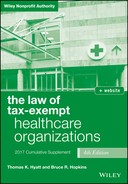Preface
This cumulative supplement accompanying the fourth edition of The Law of Tax‐Exempt Healthcare Organizations focuses on developments in the law in the tax‐exempt healthcare field since the book was published and through 2016. As in recent years, 2016 was a year of evolutionary regulatory development and guidance, rather than revolutionary.
The IRS continues to attempt to regulate the nonprofit tax‐exempt sector during a time when it has fallen into disfavor with the majority party in Congress, and perhaps with the incoming officials of the executive branch. It has sustained substantial reductions in budget and staff while being responsible for carrying the same load. Even the IRS Commissioner has been threatened with impeachment.
One fallout of this has been a marked decline in the issuance of substantive guidance in the form of revenue rulings, general counsel memoranda, private letter rulings, and even continuing professional education (CPE) text articles that have been the subject of much of the analysis provided in this text. Still, the IRS continues with useful and user‐friendly educational efforts in its online offerings and it has reduced processing time for applications for recognition of exemption to about a third of the time that was once required.
As chronicled in this supplement, the IRS this year helpfully provided more flexible guidance on the terms of permissible management services agreements with healthcare facilities financed with tax‐exempt bonds and more restrictive guidance on the qualification for exemption by accountable care organizations that operate outside of the Medicare Shared Savings Program. It also issued long‐awaited regulatory and administrative guidance on issues not unique to healthcare providers, but nevertheless of great importance and interest, including the permissible terms of deferred compensation plans that are popular with executives and a clearer path toward recognition of exemption for social welfare organizations.
The elephant in the room, however, is what awaits us in the year ahead. The most meaningful developments of the last five years for tax‐exempt healthcare organizations have been those resulting from the passage and implementation of the Affordable Care Act (ACA). The expansion of healthcare insurance coverage and access to care championed by the Act are the most substantial since the Medicare and Medicaid amendments to the Social Security Act were passed into law. And the new requirements for charitable healthcare organizations regarding community health needs assessments and financial assistance have resulted in major new regulations and herculean efforts by hospitals to implement them.
Nonetheless, we now stand on the edge of a precipice with a new Congress and a new president who have made clear their intent to repeal the Affordable Care Act at the earliest opportunity. It is also their expressed intent to replace that law with a new healthcare insurance plan, the details of which are as yet unknown. Does this mean, for example, that all of the new requirements regarding health needs assessments and financial assistance, brought about by the ACA through a revision to the Internal Revenue Code, will be eradicated? Also, the new Congress presumably now has the votes to carry out a long‐promised overhaul of the Internal Revenue Code to effectuate tax reform. What does this portend for tax‐exempt healthcare organizations?
At this point, it is unclear whether the additions to our next supplement will be extensive or minimal. In the words of the immortal Bette Davis, “Fasten your seat belts. It's going to be a bumpy night.”
